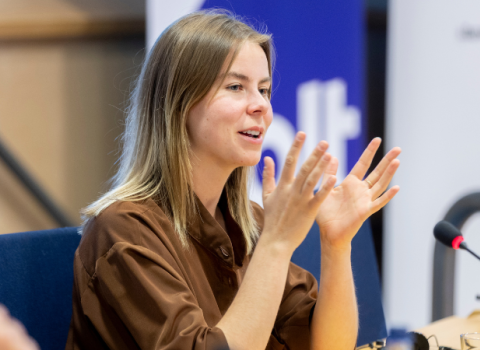Innovation in regenerative agriculture needs a broad brush approach if economic and ecological benefits are to be accurately assessed. A new project aims to scale up to landscape level to enable this

A framework for testing the innovation needed to transition to regenerative agriculture in a range of different European landscapes has been launched by the European Institute of Innovation and Technology’s (EIT) Food and Dutch agri-food ecosystem Foodvalley. EIT Food will put €15 million into the project over the next three years, matching contributions from corporate partners including Diageo, Danone and Heineken.
Regenerative agriculture aims to restore natural processes and improve the overall resilience of the food and agriculture system. However, the complexity of the food production system makes the transition to this way of working extremely challenging.
In practice, farmers do not supply a single type of customer, but channel a range of commodities to numerous stakeholders. This means that any innovation needs to be tested in an environment where all these connections, actual and potential, are in place. Only when such a framework exists is it possible to test a broad range of regenerative crops and their products, at scale.
This is what the Regenerative Innovation Portfolio aims to create. It has identified five potential priority landscapes in Europe where regional governments, investors, retailers, and others, have mutual interests and complimentary sourcing needs. Within these landscapes, the Portfolio aims to foster greater collaboration across sectors and value chains to help farmers change working practices.
EIT Food will match partner contributions of €5 million a year for three years, building up to a potential total investment of €30 million. Additionally, some activities in the Portfolio may be designed to generate a return, which will be re-invested in the project.
“It’s crucial that we establish a future-fit food system for all: a transition that can only be achieved by prioritising systemic, regenerative approaches to agriculture, in a way that keeps farmers front and centre and fosters collaboration between all stakeholders in the food chain,” said Richard Zaltzman, EIT Food’s chief executive.
“By matching funding from partners that invest in landscape-level collaborations in the Regenerative Innovation Portfolio, EIT Food aims to enable a significant commitment to the regenerative transition within Europe,” Zaltzman said.
The funding will be used to launch and support Portfolio landscape initiatives, ecosystem development and inter-landscape learning, as well as actively support participants with applications for external funding, including government subsidies, public and private grants, venture capital and angel investments.
Since starting the initial phase of the Portfolio in 2023, more than 25 companies and supporting organisations are have become involved in the programme, although only Diageo, Danone and Heineken have gone public.
Innovation for regeneration
Innovations the Portfolio will test might fall anywhere in the food production and consumption system. For example, the introduction of new crops or changes in crop rotation will lead to new patterns of supply and demand. “So, we will need innovations to steer that process, such as deal-making platforms or platforms for sourcing and trading produce,” said Jolijn Zwart-van Kessel, lead on circular agrifood innovation at Foodvalley.
Similarly, there will be a need for the produce and ingredients resulting from regenerative agriculture to be tracked, so that their value is apparent to consumers.
Then there is the aspect of regenerative agriculture that recognises ecosystem services, the environmental benefits of farming and land management. “You could imagine innovations in how you pay for ecosystems services, such as better water management in a region, and also who should pay,” Zwart-van Kessel said. There is also scope for technological solutions, such as systems to assess and track soil health, carbon capture or other environmental benefits.
Innovation will also be required to manage the risk in making the transition to regenerative agriculture, so that farmers are not carrying all the costs of effects such as reduced productivity or substantial investment in new machinery. “We don’t want the farmers to carry all that burden when we are not sure that this system will really work at scale,” said Zwart-van Kessel.
New kinds of bank loans or insurance policies might address this concern, or longer-term commitments from buyers to support the new system.
But the important point is that all these innovations should be tested together, in an integrated system aimed at regenerative agriculture. “We will be looking at a wide variety of innovations, in order to figure out together what really works on a larger scale, and what is sustainable economically as well as ecologically,” said Zwart-van Kessel. “We are looking for a system that can sustain itself without having everything done by subsidy. So, it has to be a viable new business model.”
Figures in the landscape
While supporting farmers is the central goal, the starting point needs to be the companies and other organisations that buy their produce, or who might pay for ecosystem services.
“On the supply side, farmers are usually quite willing to work on regenerative agriculture, but only if there is an incentive,” said Zwart-van Kessel. So, the Portfolio has begun by talking to companies and other partners interested in sourcing regeneratively produced raw materials.
“We’ve mapped out those discussions and looked for places where their interests connect, preferably for different crops, so that there is a potential benefit to collaboration in that region,” she said. “It’s about how companies can collaborate together, with different off-takes of different crops, and support farmers in making the transition.”
Each landscape identified in this way should be an economically and ecologically recognisable region, with a distinct climate, soil type and crops, and sufficient area to test regenerative agriculture at scale. The first Portfolio landscape will be in the Navarre region of northern Spain, where the focus is arable crops such as oats and wheat.
Others will follow, some starting from scratch, others building on existing initiatives. “Sometimes it will be landscapes that are already somewhat along the way, but which need additional acceleration or help in finance, and would benefit from the portfolio approach,” Zwart-van Kessel said.
A large regenerative agriculture community will be starting this spring that will have connections to all the landscapes, and a special track for partners that invest in the landscapes to support exchanges between the different projects.
“The aim is to fit in all the different ‘blood groups’ that we need, for instance the tech solutions, the legal knowledge, farmers, investors and food companies, and start-ups with a variety of low and high tech innovations, so that they can come together, think of solutions, collaborate and develop them together,” said Zwart-van Kessel.
A role for start-ups
While some of the innovation required will be developed in the communities, others will emerge as they begin work. Then the plan is to invite bids for solutions that can then be piloted in the landscape.
This is where technology-based start-ups can be expected to play a role. “We will need companies like start-ups that have innovative solutions that we can plug in at different stages in that value chain, or maybe help farmers in their transition,” said Zwart-van Kessel.
This might apply to relatively mature solutions, or approaches earlier in their development. “If we want to reach scale, we need solutions that have taken the first steps and proven that they have something that works,” she said. “On the other hand, if a start-up has a really interesting proposition that needs testing, then we should have enough space in our landscapes to make connections and see how it can fit.”
EIT Food already has a broad range of companies on its books which might take advantage of these opportunities, proposing options for reducing chemical inputs, for example, or for tracking ecosystem services. Belgian start-up Soil Capital is developing a certified, multi-national carbon payment programme, through which farmers earn new revenue for mitigating their climate impact, while Smart Cloud Farming of Germany is combining satellite and ground data to help assess the carbon sequestration potential of soils.
Alternative fertilisers are proposed by companies such as Toopi Organics in France, which is collecting and processing human urine to extract nitrogen, phosphorus and potassium, and by biofertiliser company Ekolive from Slovakia. Diagnostic systems, such as those proposed by Verdi Technologies in the Netherlands, can help minimise the use of pesticides.
The ultimate aim of the Portfolio is to establish a diverse set of landscapes that can learn from each other’s experience.
“We are looking for a wide range of different solutions, for different soil types, for different economic systems, and also for different regional systems in terms of ecological, social and economic factors,” said Zwart-van Kessel. “Three years of investment will not be enough to implement regenerative agriculture across Europe, but it will incentivise people, and help find pathways and solutions that can be shared, so that others can use them, build on them, and scale from there.”
Elsewhere in the Ecosystem…
- The first EIT Alumni Node opens this month in Barcelona, at the headquarters of EIT Urban Mobility. The aim is to provide a dedicated space for alumni to convene for networking sessions, start-up idea development, and meetings with potential investors and customers. It should also help develop collaborations with the local ecosystem of start-up founders and innovators. A second European node will be announced in due course.
- Aignostics, a 2018 spin-off from the Charité university hospital in Berlin, has announced a strategic collaboration with Bayer to work on applying artificial intelligence to drug discovery and clinical development. The partners will create a novel target identification platform, and develop computational pathology algorithms that connect baseline pathology imaging data and molecular tumour profiles, with patient outcomes.
- Dutch venture capital company DeeptechXL has raised €110 million for its latest fund, with support from semiconductor company ASML and the PME pension fund, amongst others. The fund specialises in deep-tech investments, notably in photonics and quantum computing.
- London-based start-up ThinkSono has raised £2.1 million to support development of an artificial intelligence system to guide ultrasound measurements. The system allows healthcare staff who are not trained in the use of ultrasound to scan patients suspected to have deep vein thrombosis and send the data for review by a qualified clinician. The company was founded in 2016 through the Entrepreneur First venture building programme.





 A unique international forum for public research organisations and companies to connect their external engagement with strategic interests around their R&D system.
A unique international forum for public research organisations and companies to connect their external engagement with strategic interests around their R&D system.